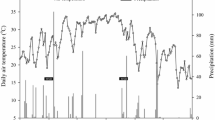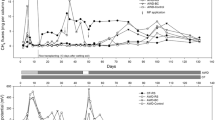Summary
The efficiency of N use in flooded rice is usually low, chiefly due to gaseous losses. Emission of CH4, a gas implicated in global warming, can also be substantial in flooded rice. In a greenhouse study, the nitrification inhibitor encapsulated calcium carbide (a slow-release source of acetylene) was added with 75, 150, and 225 mg of 75 atom % 15N urea-N to flooded pots containing 18-day-old rice (Oryza sativa L.) plants. Urea treatments without calcium carbide were included as controls. After the application of encapsulated calcium carbide, 3.6 μg N2, 12.4 μg N2O-N, and 3.6 mg CH4 were emitted per pot in 30 days. Without calcium carbide, 3.0 mg N2, 22.8 μg N2O-N, and 39.0 mg CH4 per pot were emitted during the same period. The rate of N added had a positive effect on N2 and N2O emissions, but the effect on CH4 emissions varied with time. Carbon dioxide emissions were lower with encapsulated calcium carbide than without. The use of encapsulated calcium carbide appears effective in eliminating N2 losses, and in minimizing emissions of the “greenhouse gases” N2O and CH4 in flooded rice.
Similar content being viewed by others
References
Aulakh MS, Rennie DA, Paul EA (1984) Acetylene and N-Serve effects upon N2O emissions from NH +4 and NO −3 treated soils under aerobic and anaerobic conditions. Soil Biol Biochem 16:351–356
Banerjee NK, Mosier AR (1989) Coated calcium carbide as nitrification inhibitor in upland and flooded soils. J Indian Soc Soil Sci 37:306–313
Bouwman AF (1990) The role of soils and land use in the greenhouse effect. In: Bouwman AF (ed) Soils and the greenhouse effect. Chichester: John Wiley, pp 575
Bremner JM, Blackmer AM (1979) Effects of acetylene and soil water content on emission of nitrous oxide from soils. Nature (London) 280:380–381
Buresh RJ, De Datta SK (1990) Denitrification losses from puddled rice soils in the tropics. Biol Fertil Soils 9:1–13
Buresh RJ, De Datta SK, Padilla JL, Samson MI (1988) Field evaluation of two urease inhibitors with transplanted lowland rice. Agron J 80:763–768
Cao ZH, De Datta SK, Fillery IRP (1984) Effect of placement methods on floodwater properties and recovery of applied N [15N-labeled urea in wetland rice. Soil Sci Soc Am J 48:196–203
Carter MF, Vlek PLG, Touchton JT (1986) Agronomic evaluation of new urea forms for flooded rice. Soil Sci Soc Am J 50:1055–1060
Cicerone RJ, Shetter JD (1981) Sources of atmospheric methane: Measurements in flooded rice paddies and a discussion. J Geophys Res 86:7203–7209
Cribbs WH, Mills HA (1979) Influence of nitrapyrin on the evolution of N2O from organic medium with and without plants. Commun Soil Sci Plant Anal 10:785–794
De Bont JAM, Mulder EG (1974) Nitrogen fixation and cooxidation of ethylene by a methane-utilizing bacterium. J Gen Microbiol 83:113–121
De Datta SK (1981) Principles and practices of rice production. John Wiley, New York
Fillery IRP, Simpson JR, De Datta SK (1986) Contribution of ammonia volatilization to total nitrogen loss after applications of urea to wetland rice fields. Fert Res 8:193–202
Freney JR, Denmead OT, Watanabe I, Craswell ET (1981) Ammonia and nitrous oxide losses following applications of ammonium sulfate to flooded rice. Aust J Agric Res 32:37–45
Holzapfel-Pschorn A, Seiler W (1986) Methane emission during a cultivation period from an Italian rice paddy. J Geophys Res 91:11803–11814
Hutchinson GL, Mosier AR (1981) Improved soil cover method for field measurement of nitrous oxide fluxes. Soil Sci Soc Am J 45:311–316
Knowles R (1979) Denitrification, acetylene reduction, and methane metabolism in lake sediment exposed to acetylene. Appl Environ Microbiol 38:486–493
Kruskal WH, Wallis WA (1952) Use of ranks in one-criterion variance analysis. J Am Stat Assoc 47:583–621
Lindau CW, Delaune RD, Patrick Jr WH, Bollich PK (1990) Fertilizer effects on dinitrogen, nitrous oxide and methane emissions from low-land rice. Soil Sci Soc Am J 54:1789–1794
Mohanty SK, Mosier AR (1990) Nitrification-denitrification in flooded rice soils. Trans 14th Int Congr Soil Sci (Kyoto, Japan) IV:326–331
Mosier AR, Mack L (1980) Gas chromatographic system for precise, rapid analysis of N2O. Soil Sci Soc Am J 44:1121–1123
Mosier AR, Guenzi WD, Schweizer EE (1986) Soil losses of dinitrogen and nitrous oxide from irrigated crops in Northeastern Colorado. Soil Sci Soc Am J 50:344–348
Mosier AR, Chapman SL, Freney JR (1989) Determination of dinitrogen emission and retention in floodwater and porewater of a lowland rice field fertilized with 15N-urea. Fert Res 19:127–136
Mosier AR, Mohanty SK, Bhadrachalam A, Chakravorti SP (1990) Evolution of dinitrogen and nitrous oxide from soil to the atmosphere through rice plants. Biol Fertil Soils 9:61–67
Ponnamperuma FN (1972) The chemistry of submerged soils. Adv Agron 24:29–96
Raimbault M (1975) Étude de l'influence inhibitrice de l'acetylene sur la formation biologique du methane dans un sol de rizière. Ann Microbiol (Inst Pasteur) 126A:247–258
Rodhe H (1990) A comparison of the contribution of various gases to the greenhouse effect. Science 248:1217–1219
Rolston DE (1986) Gas flux. In: Klute A (ed) Methods of soil analysis: part 1, Physical and mineralogical methods. Am Soc Agron, Madison, Wisconsin, pp 1103–1119
SAS Institute (1985) SAS user's guide: Statistics, Version 5. Statistical Analysis System Institute Inc, Cary, North Carolina
Schütz H, Holzapfel-Pschorn, Conrad R, Rennenberg H, Seiler W (1989a) A three year continuous record on the influence of daytime, season and fertilizer treatment on methane emission rates from an Italian rice paddy field. J Geophys Res 94:16405–16416
Schütz H, Seiler W, Conrad R (1989b) Processes involved in formation and emission of methane in rice paddies. Biogeochemistry 7:33–53
Shapiro SS, Wilk MB (1965) An analysis of variance test for normality (complete samples). Biometrika 52:591–611
Simpson JR, Freney JR, Muirhead WA, Leuning R (1985) Effects of phenylphosphorodiamidate and dicyandiamide on nitrogen loss from flooded rice. Soil Sci Soc Am J 49:1426–1431
Author information
Authors and Affiliations
Rights and permissions
About this article
Cite this article
Bronson, K.F., Mosier, A.R. Effect of encapsulated calcium carbide on dinitrogen, nitrous oxide, methane, and carbon dioxide emissions from flooded rice. Biol Fertil Soils 11, 116–120 (1991). https://doi.org/10.1007/BF00336375
Received:
Issue Date:
DOI: https://doi.org/10.1007/BF00336375




